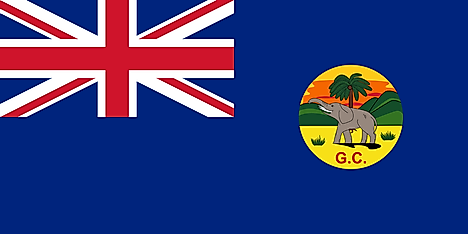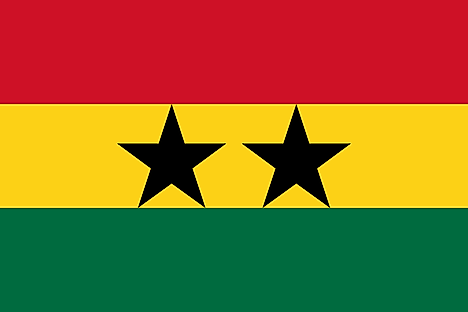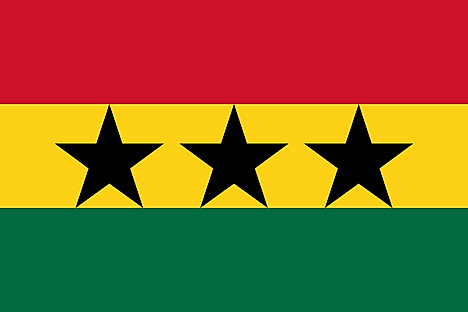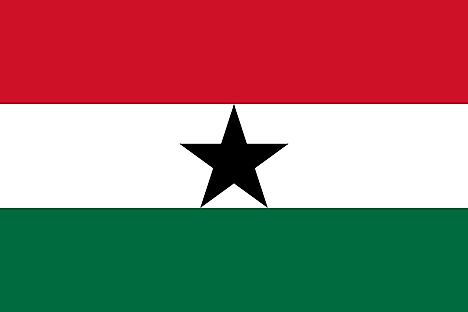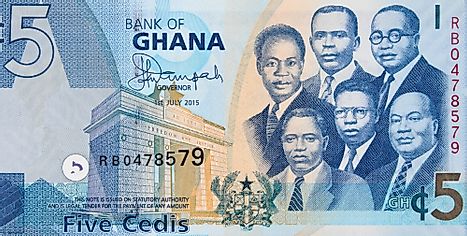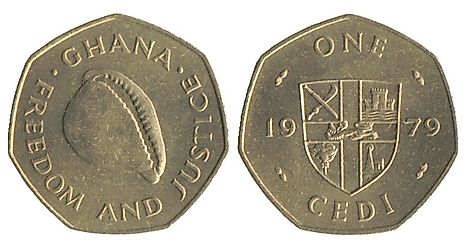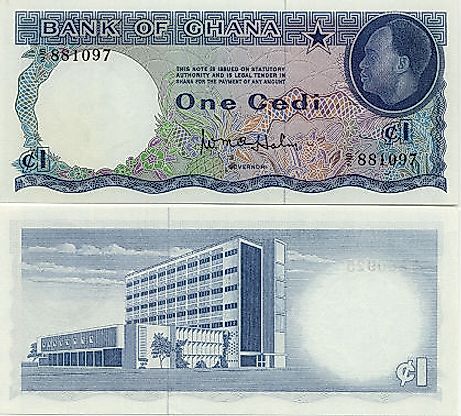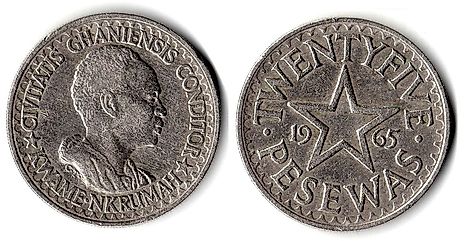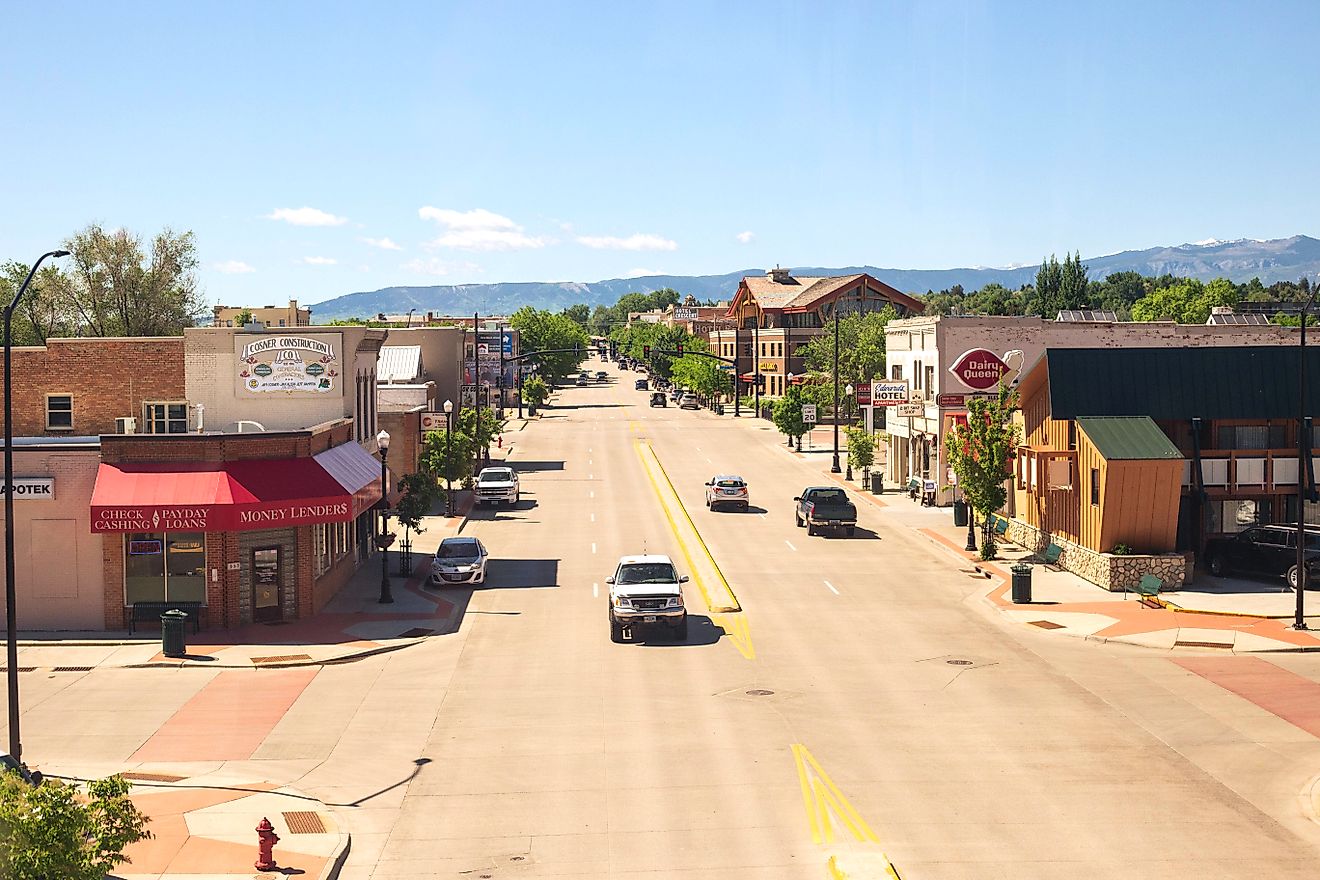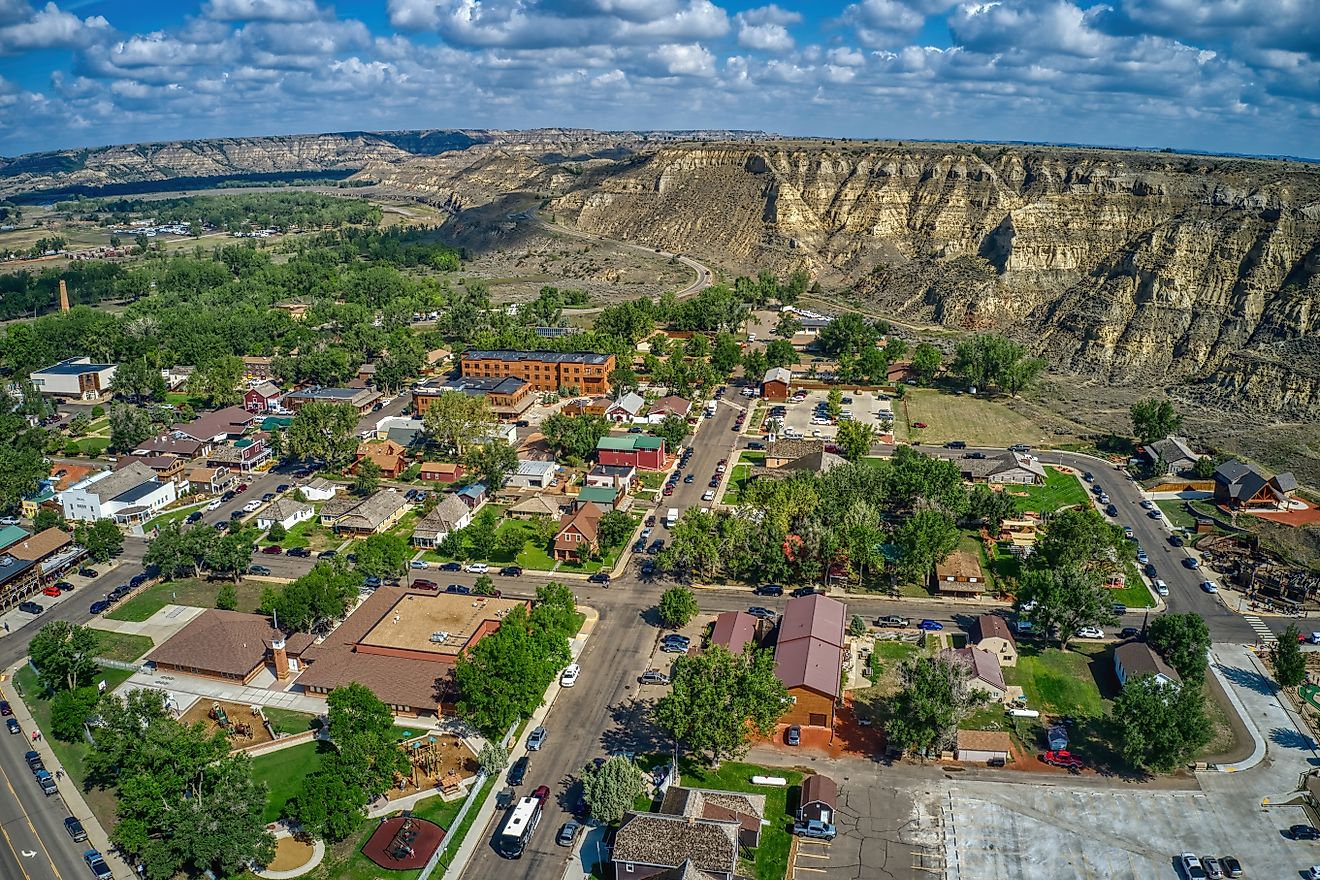Flags, Symbols, & Currencies of Ghana
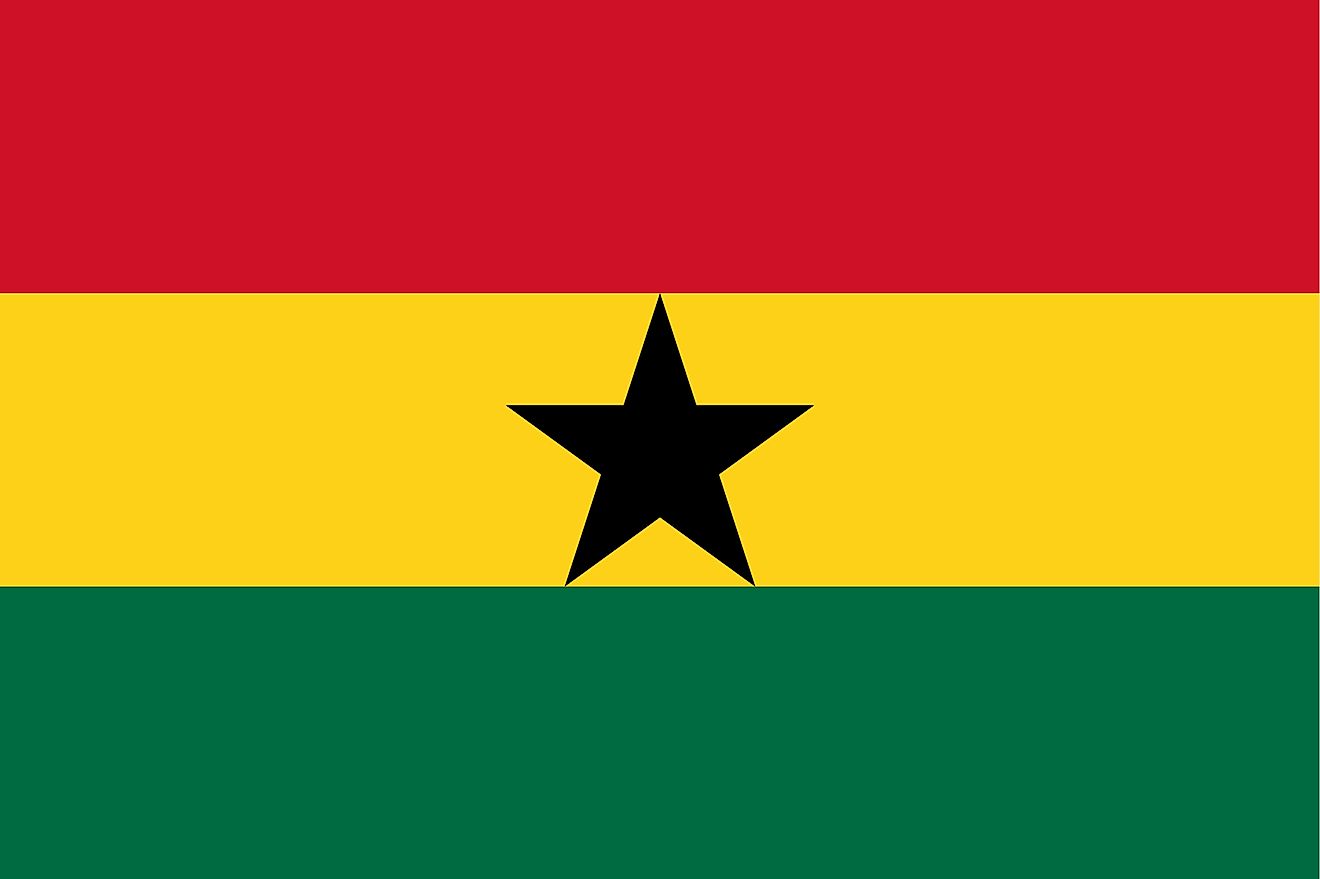
The national flag of Ghana was designed in 1957 by Theodosia Okoh and was adopted at independence the same year. The new flag replaced the Union Jack, used in all countries colonized by the British.However, the flag of Ghana was used until 1959 when Guinea and Ghana came together to form the Union of African State. But, Ghana readopted the flag on February 28, 1966.
The flag of Ghana features three equal horizontal bands of red (top), yellow, and green, with a large five-pointed black star centered in the yellow band. The red color symbolizes the blood shed during the struggle independence, yellow represents the country's mineral wealth, while green stands for its forests and natural wealth. The the black star symbolizes the unity against the colonial forces and also represents Africa's. emancipation.
History of the Flag
Before colonization, the flag of the Kingdom of Ashanti was the main flag flown in Ghana. However, after the arrival of the British, the kingdom was absorbed into Gold Coast and the flag replaced by a colonial flag. The colonial flag was a blue ensign with a seal, and was used until 1957. The tricolor flag was adopted upon independence but was later defaced with an additional black star to represent the union between Guinea and Ghana. When Mali joined the Union, an additional black star was included on the flag. The new flag used between 1961 and 1964 had three stars to represent the three coutries that formed the union. Following a referendum in 1964, the three stars were replaced with one star and the yellow band with a white band (color of the ruling party). The original flag of 1957 was readopted in 1966.
Symbols of Ghana
National Coat of Arms of Ghana
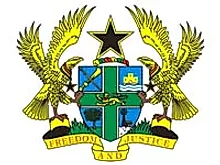
The coat of arms of Ghana is composed of a blue shield displaying a St. George's cross supported by two golden eagles. Centered within the shield is a golden lion symbolizing Ghana's close relationship to the United Kingdom, and the black star above the shield is a symbol for the freedom of Africa. The national motto of Ghana: "Freedom and Justice" is displayed on a ribbon below the shield.
National Anthem
- Anthem Title: God Bless Our Homeland Ghana
- Music composer: Philip Gbeho
- Lyricist: Emmanuel Pappoe-Thompson
- Date of Adoption: 1957
The national anthem of Ghana is titled "God Bless Our Homeland Ghana" and was adopted at independence in 1957. This anthem was composed by Philip Gbeho. Although Emmanuel Pappoe-Thompson was the lyricist, the lyrics were revised by Kwame Gbordzoe.
God Bless Our Homeland Ghana
God bless our homeland Ghana
And make our nation great and strong,
Bold to defend forever
The cause of Freedom and of Right;
Fill our hearts with true humility,
Make us cherish fearless honesty,
And help us to resist oppressors' rule
With all our will and might for evermore
Hail to thy name, O Ghana,
To thee we make our solemn vow:
Steadfast to build together
A nation strong in Unity;
With our gifts of mind and strength of arm,
Whether night or day, in the midst of storm,
In every need, whate'er the call may be,
To serve thee, Ghana, now and for evermore.
Raise high the flag of Ghana
and one with Africa advance;
Black star of hope and honour
To all who thirst for liberty;
Where the banner of Ghana freely flies,
May the way to freedom truly lie;
Arise, arise, O sons of Ghana land,
And under God march on for evermore!
The Currency of Ghana is the Ghanaian cedi
The official currency of Ghana is the Ghanaian cedi, represented by the sign GH₵. Each cedi is subdivided into one hundred pesewas (Gp). After independence, Ghana stopped using British currency and chose the Ghanian pound, used from 1958 to 1965. The introduction of the name "cedi" came between 1965 to 1967 and it replaced the remote British pound system. The cedi was introduced by President Kwame Nkrumah.
In 1966, a military coup ended the leadership of Nkrumah and a new leader took over. The new individuals running the country initiated the introduction of the new cedi between 1967 and 2007 with the intention to remove the face of the first president, Kwame Nkrumah. However, an extended period of inflation diminished the new currency and it was slowly removed. In 2007, the Ghana cedi was traded at 1:10,000. The 20,000 banknote that was introduced in 2007 became the largest unit note in Africa. However, its value has depreciated over the years.
Coins
The issuance of Ghanaian coins is the responsibility of the Bank of Ghana, which has been minting coins since 1958. The coins that are currently in circulation are in the denominations of 1 pesewa, 5 pesewas, 10 pesewas), 20 pesewas, 50 pesewas, 1 cedi, and 2 cedis
Banknotes
The Bank of Ghana has circulated the Ghanaian notes since 1958. A number of features have been changed to counter the production of fake notes. The imprint signature changes when a new governor assumes the responsibilities of managing the Bank of Ghana. No printing year is indicated on any note.The Ghanian cedi banknotes are in the denominations of 1, 2, 5, 10, 20, 50, 100, and 200.
Commemorative Coins
Bank of Ghana has also issued several commemorative coins. These coins have been minted under different names, including in pounds (1958 to 1977), shillings (1958), crowns (1965), sikas (1997 to 2003), and cedi (2003 to date).
Historical Currencies of Ghana
The First Cedi and the Second Cedi
The “new cedi” replaced the first cedi in 1967 at the rate of 1 new cedi = 1.2 first cedi, allowing for decimal exchange with the pound. One pound exchanged for 2 "new" cedis.
One British pound could be exchanged with 2 old cedis. However, after a few months the second cedi had depreciated and the trade rate was one pound for 2.45 second cedi. This was lower than the worth of the first cedi. An improvement in the cedi value occurred in 1967 following the depreciation of the British pound. However, inflation eventually weakened the cedi again and it dropped to an exchange rate of 2.80 cedis=$1.00.
Inflation kept weakening the worth of the cedi and government intervention worsened the situation. In 2007, the cedi exchanged at at 9500 cedis to one United States dollar, leading to the introduction of the third cedi.
The Third cedi (GHS)
The third cedi bore the official name Ghanian Cedi while circulating together with the second cedi in 2007. However, by December 2007, at least 90% of the first and second cedi coins were no longer in circulation. In 2008, old notes were no longer accepted in the banks and became illegal for tendering. In May 2010, a note of GH₵2 was introduced due to the market demand. There was also a lower attached cost of producing large volumes of GH₵1. The Ghanaian Cedi had been devaluing since its introduction until the end of 2014 when IMF accepted to bail out the Ghana government, causing the currency to steady.
